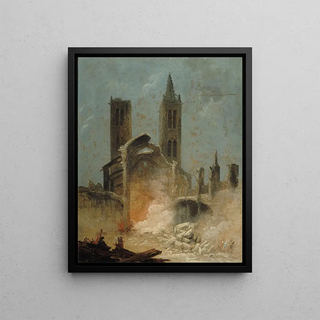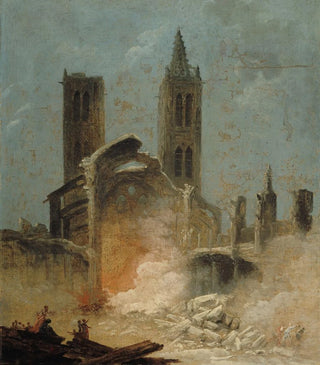Art print | The Demolition of the Saint-Jean-en-Grève Church in 1800 - Hubert Robert


View from behind

Frame (optional)
Reproduction La Démolition de l'église Saint-Jean-en-Grève en 1800 - Hubert Robert – Captivating introduction
The artwork "La Démolition de l'église Saint-Jean-en-Grève en 1800" by Hubert Robert immerses us in a significant event in Parisian history. This piece, far more than a simple depiction, is a poignant testament to an era of upheavals and transformations. Through this work, the artist captures the very essence of the architectural and social changes that shook the capital at the end of the 18th century. The scene depicts not only the destruction of a church but also the clash of revolutionary ideals confronting tradition. In a setting where the past fades away, Hubert Robert invites the viewer to reflect on the fragility of heritage and the impact of time on our collective memory.
Style and uniqueness of the work
Hubert Robert's style is distinguished by his ability to blend the sublime and the tragic. In "La Démolition de l'église Saint-Jean-en-Grève," the artist employs a palette of colors that is both vibrant and melancholic, creating a striking contrast between light and shadow. The ruins of the church, majestically depicted, seem almost to dialogue with the workers busy around them. The architectural details, carefully rendered, reveal Robert's love for structure and form, while the human figures, though secondary, add a dimension of life and emotion to the composition. The perspective chosen by the artist offers a panoramic view that allows appreciation of the extent of the destruction, while also suggesting a certain nostalgia for what is lost forever. This work thus stands out for its skill in evoking a complex story through a simple demolition scene.
The artist and his influence
Hubert Robert, often nicknamed the "painter of ruins," is an artist whose work profoundly influenced the artistic landscape of the 18th century. Trained at the Royal Academy of Painting and Sculpture, he developed a unique style that combines romanticism and classicism. His interest in ruins and landscapes reflects a particular sensitivity to the passage of time and memory. Through

Matte finish

View from behind

Frame (optional)
Reproduction La Démolition de l'église Saint-Jean-en-Grève en 1800 - Hubert Robert – Captivating introduction
The artwork "La Démolition de l'église Saint-Jean-en-Grève en 1800" by Hubert Robert immerses us in a significant event in Parisian history. This piece, far more than a simple depiction, is a poignant testament to an era of upheavals and transformations. Through this work, the artist captures the very essence of the architectural and social changes that shook the capital at the end of the 18th century. The scene depicts not only the destruction of a church but also the clash of revolutionary ideals confronting tradition. In a setting where the past fades away, Hubert Robert invites the viewer to reflect on the fragility of heritage and the impact of time on our collective memory.
Style and uniqueness of the work
Hubert Robert's style is distinguished by his ability to blend the sublime and the tragic. In "La Démolition de l'église Saint-Jean-en-Grève," the artist employs a palette of colors that is both vibrant and melancholic, creating a striking contrast between light and shadow. The ruins of the church, majestically depicted, seem almost to dialogue with the workers busy around them. The architectural details, carefully rendered, reveal Robert's love for structure and form, while the human figures, though secondary, add a dimension of life and emotion to the composition. The perspective chosen by the artist offers a panoramic view that allows appreciation of the extent of the destruction, while also suggesting a certain nostalgia for what is lost forever. This work thus stands out for its skill in evoking a complex story through a simple demolition scene.
The artist and his influence
Hubert Robert, often nicknamed the "painter of ruins," is an artist whose work profoundly influenced the artistic landscape of the 18th century. Trained at the Royal Academy of Painting and Sculpture, he developed a unique style that combines romanticism and classicism. His interest in ruins and landscapes reflects a particular sensitivity to the passage of time and memory. Through






